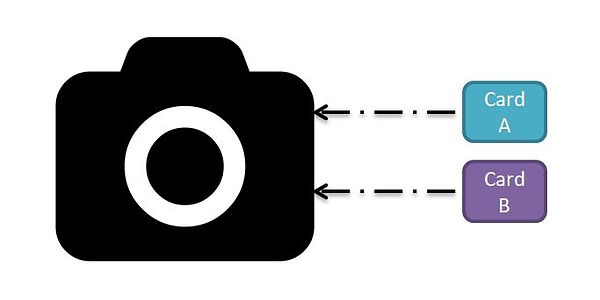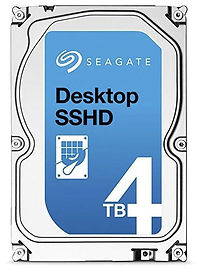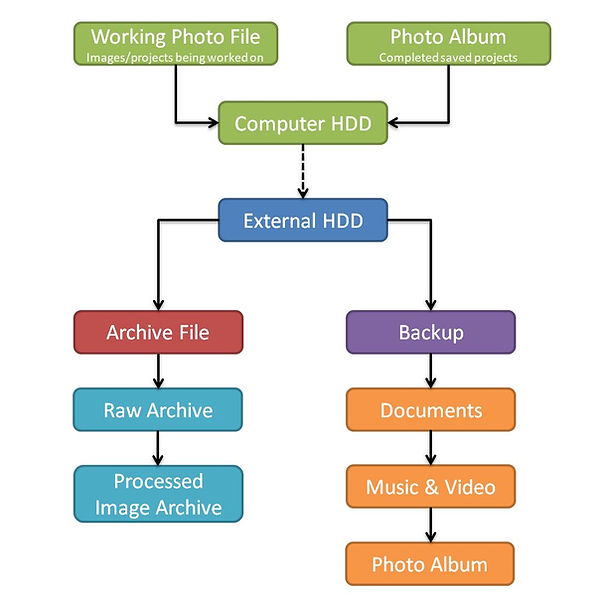
LENSClof
Photography Blog

How to Store and Backup Your Photographs
Do you have you images backed-up?
Why do you need a back-up?
What will it cost?
How difficult is it?
This article covers the most popular approaches for securing, saving, protecting and archiving those precious images. These are the methods employed by the majority of photographers. How you use these methods is your choice and you need to find an approach that works for you, but this should help you decide on an approach.
What is a Backup
The best place to start is always at the beginning!
Definition of a Backup:
A backup, or data backup, or the process of backing up, refers to the copying into an archive file of computer data that is already in secondary storage—so that it may be used to restore the original after a data loss event.
Or in very simple terms - You have a spare copy
Why Backup?
Memory cards or computer systems or disk drives drives will fail or be attacked.
Where do you Backup?
In camera, In Computer, Outside computer, Off Site
In Camera Backup
Yes this process actually begins as you are taking your photographs.
Many cameras these days have two card slots and typically these two card slots can work in the following ways;
Option 1
Option 2
Option 3 ✔
So you should be using Option 3 and why you may ask?
-
Memory card will fail
-
Memory cards are relatively cheap these days
-
If card A fails then all of your images are safe on card B
You are backed up
Some additional points.
-
Often the card slots are for different types of Memory cards
-
Put your fastest card in slot A if the camera saves to that slot first
-
Typically in speed order XQD > Compact Flash > SD
-
-
Make sure the cards are the same size eg
-
Card A 64Mb and Card B 64Mb
-
-
Ideally ensure that the cards are the same speed in their transfer rates mb/sec as the slowest card will dictate the speed
Another point you should consider is the size of the card and if you go for big cards or go for smaller cards which will need changing.
- Your choice?
Do you put all your eggs in one basket?
This card is used to save the photograph in a RAW format
This card is used to save the photograph in a Jpeg format
This card is used first to save your photographs
This card is used to save the photographs after Card A is full
This card is used to save your photographs
This card is also used to save your photographs in the same format as Card A
CARD A
CARD B

In Computer Backup
First of all lets look at a standard computer and what it contains

As you will be aware your computer, desk station or laptop, contains a hard drive (HDD) and this is where all of your images are stored. There are 3 types of hard drive and which type of drive can have some influence on the chances of it failing and the associated loss of images.
Mechanical (HDD)
This is the traditional style of drive and it contains a series for spinning discs and a mechanism or actuator arm that saves the data onto the disks and also reads the data from the disks.
Pros - Cheap, can rewrite many many times
Cons - Mechanical, not as safe to transport as SSD, Slow compared to SSD

Hybrid Solid State (hybrid HSSD)
Contains two elements a small non mechanical drive SSD section that is used for the operating system and a mechanical section with an actuator arm that is used for data storage
Pros - Little more expensive, can rewrite many many times
Cons - Mechanical, not as safe to transport as SSD, Slow compared to SSD

Solid State Drive (SSD)
Contains a series of micro chips on a card and has no moving parts to it.
Pros - Very fast, No mechanical section with an actuator arm. Safe to transport
Cons - Most expensive, older models can rewrite a limited number of times (still a lot)

The Option already on Your Computer
This does not matter if you have a PC or a Mac they both come with a system that will back up your files so that if you accidental delete a file you can recover it.
Mac Option
This is called Time Machine and comes as part of the operating software all you need to do is set it up correctly
https://www.imore.com/how-back-up-mac-time-machine
PC Option
This is called File History and comes as part of the operating software all you need to do is set it up correctly
https://www.pcworld.com/article/2974385/how-to-use-windows-10s-file-history-backup-feature.html
If you are activating these on the computer you purchased and using the HDD on the computer then you are in a better place because you can recover deleted files and go back to previous versions.
You are still vulnerable to disk failure, viruses and don't have an archive capability.
To get the most out these systems you should be saving to a totally separate drive

How Does in Computer Backup Work
Your computer contains a hard drive which is where the data is stored.
It is possible to add a second hard drive to the system and connect the two hard drives in such a way that anything recorded on drive A is simultaneously saved on drive B.
This is the same principle as option 3 in the In Camera Backup section.
It should be noted that raid drives are not backups
These are the called RAIDED Drives.
So the same data is stored and drive A and drive B so if A were to fail you data is safe on drive B.
There are several ways of setting these up and its best to go to a professional web based explanation if you want to understand the technicalities
https://www.pcworld.com/article/132877/raid.html
This next part works slightly differently for Apple Computers and PC's due to space constraints.
Desk stations
-
Some of these can have raid drives added post purchase if the unit has spare "bays" to enable additional drives to be added.
PC - Yes
Mac - Not Possible
-
You can purchase your computer pre- built with raided drives.
Companies such as Chillblast supply such machines.
https://www.chillblast.com/desktop-pcs/choose-by-task/photo-video
PC - Yes
Mac - Not Possible
Laptops
-
Typically laptops are built to minimise size so their is insufficient space in the case for an additional drive
PC - Not Possible
Mac - Not Possible
External Raid Drive
-
You can have an external Raid drive that sits outside your computer a good example is
D 4 TB My Book Desktop Hard Drive
This will work for Apple or PC desk station or laptop. You will need to ensure you size the raid drive is sized sufficiently to cover you main machine drives.
PC - Yes
Mac - Yes
Outcome
So if you have followed the above and added a raided drive to you system you are backed up should you main data drive on you computer fail.

Mid Point Review
What have we achieved so far?
We have allowed for and mitigated
-
In camera storage device failure ✔
-
In computer failure of our main drive ✔
We have not achieved
-
Actual backup outside of our main operating systems
-
Off site backup.
This means you images are stored away from where you operate so in a worst case scenario of fire or flood they are not lost. -
Successfully achieving this will create space on you system and stop it clogging up.
An archive system
Off Computer Backup & Archive
The focus of this option is to store your images outside of your main computer and also to archive them within you full control.
CD's, DVD's, Blu Rays, Flash Drive's
These are ok to use in a limited way but they have too may disadvantage to make them a genuine viable option. They all suffer from a number of these issues;
-
Low storage capability
-
Old technology that may soon disappear
-
New computers don't have the capacity to read them
-
Not the cheapest option when you compare like with like
-
They will decay or degrade with time
-
Once created they are fixed
-
Difficult to store
Off Computer Independent HDD
This concept may appear similar to a Raid Drive but is in fact a totally different option.These are sometimes referred to as a DAS (Direct-attached storage) device
This system uses HDD's that are connected to your computer but work totally independently and are controlled by you. You connect an external HDD to your computer and you decided whae you turn it on and off and when you save or archive data
There are two different ways of doing this
-
Attach an external HDD to you computer
-
Attach a HDD docking station
External HDD
These drives can be purchased as SSD or standard HDD
The Seagate 4 TB Backup Plus USB 3.0 Portable 2.5 Inch External Hard Drive for PC and Mac is a typical option.
Pros:
-
Cheap option
-
Very easy to install
-
Modern ones are quite small
-
You can take the drive with you
and easily connect it to another computer
Cons:
-
Will use a USB point
-
as this is the typical connection point
-
-
When its full you need to add another
Tip:
-
Ensure you invest in a large capacity drive as that will work out cheaper in the long run
-
Decide on you filing system and follow it or you wont be able to find things
-
I would suggest the following structure
-
Installation is simple for both PC and Mac
https://www.wikihow.com/Add-an-External-Hard-Drive-to-Your-Computer
There is a system for connection and disconnection that should be followed to avoid damage to the drive.
https://www.computerhope.com/issues/ch001876.htm
How Does it work
Once this connected, formatted and visible on your computer you are good to go.
You need to ensure you are organised and have a good file structure
Something like this;


I would suggest using this drive in the following way
-
Set aside a slot at the start of each month for computer house keeping
-
Update the Backup aspects as you go
-
Once a month do your archiving
-
Only turn the external derive on when you need it then it is protected from viruses and ransom ware
-
It is labour intensive but it works ok
HDD Docking station
This is a unit that connects to your computer and allows to to connect muliple external HDDs to your compute and then interchange them.
Firstly the Docking Station itself
The inateck USB 3.0 to SATA 2-Bay USB 3.0 Hard Drive Docking Station with Offline Clone Function is a good example and possesses the majority of features you should be looking for;
-
Hot swap capability (still better not to hot swap)
-
Fast transfer speeds
-
USB 3.0
-
Can take standard computer 3.5" HDD with a Sata connection
-
Can take standard laptop 2.5" HDD with a Sata connection
-
Can clone one drive onto another

Once you have purchased your docking station follow the instructions and connect to the computer which should be a simple plug and play exercise.
https://www.youtube.com/watch?v=EKyblCkSGok
With the unit connected the use of the system you simply place a 3.52 or 2.25 inch sata HDD into the unit and turn it on. If the unit is going to be turned on only when you need it then 7200 rpm drives can be used if however its going to be left on constantly you may need to use a NAS drive 5400rpm (check with your docking station supplier)
You will need to initialise and format the drives.
https://www.youtube.com/watch?v=ZxV6IcNvbek
https://www.youtube.com/watch?v=eDeCVUFl-Ac
https://www.laptopmag.com/articles/format-drive-for-windows-and-mac
So now you have this setup how do you use it?
-
You can add and remove different drives
-
You can have different drives for different things
-
its easy to have an archive drive
-
if for added security you want to copy a drive then the clone function will assist with this
You now have the ability to Off-Computer archive and backup with total flexibility with drives store remotely even if the worst thing happens to you computer you data is stored safe on a shelf.
Remember to purchase HDD storage cases so the drives are kept clean and safe when not in use
A fancier way of doing this is with a unit such as a Drobo DRDR6A31 5D3 5 Bay Desktop DAS Enclosure which holds up to 5 drives and offers greater flexibility and control.
Visit the Drobo site where they offer photography tailored solutions for PC and Mac
https://www.drobo.com/photography/
The choice on which option you use will probably come down to how much you want to spend and how much you want to control things. Both of these docking station options are good solutions - it all depends what you want?



What can we expect in Part 2
-
Nas Drives
-
Cloud Storage
-
Review of all the Options
-
A proposed best answer
(if there is one ?)